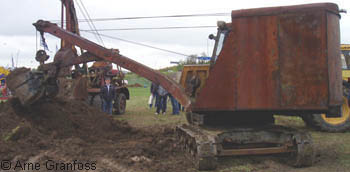British and allied intelligence

 UNDER CONSTRUCTION Version 0.3
UNDER CONSTRUCTION Version 0.3
|
Sweden in World War II - across borders
|
 |
![]()
The British Special Operations Executive (SOE) seems to have prepared a secret sabotage and intelligence organisation in Sweden, with Swedish persons, in case of a German occupation or similar. [s50]
![]()
![]()
Britain gave the USA disguised information from their secret encryption of German communications in the second half of 1941, to help USA ships avoid German submarines in the Atlantic. By late 1942 they provided additional assistance to among others Sweden. [s27]
![]()
A day in early August 1943 a 23 years old student at the technical high school in Trondheim arrived with the local boat to Kjækan in northern Norway. He had brought his bicycle, and after some 60 kilometres on gravel roads he came to the house of friends to the family. The Germans had commandeered their house and the family had been forced to move, but their fox farm was still there. The village had 300 inhabitants before the war. Now there were more than 6000 German soldiers in the area. The student should spend a short time there, both to feed the foxes and have some leisure time. Among others he borrowed the family's rowboat to fish in the fjord. [s51]
The box he used for the food to the foxes also contained a binocular and a protractor, and when he sat down reading a Norwegian nazi newsparer he added notes on the map that was hidden in the newspaper. On his way with the bicycle he had memorized the surroundings, with barracks, guns, fortifications et cetera. Also the German warships that he had passed, among then the heavy cruiser Lützow and the battleships Scharnhorst and Tirpitz. While he caught some fishes, at the side of Tirpitz with sailors who applauded as he caught the first fish, he managed to take water samples from different dephts with an instrument hidden in the handle of the fishing-rod. [s51]
A sami had helped to collect information. He too had taken water tests, and also rowed along the protecting torpedo nets - dressed in traditional sami clothes, with German sailors taking photos of him, he had used his heavy knife to measure the depth along the torpedo net. [s51]
After some days the student came to Tromsø and handed over the information to a SIS radio operator. The student had finished another assignment for the British Secret Intelligence Service. The map was sent with a courier to Sweden, and on to London. This was one part of the preparations for what has become history in text and movie and documentaries - the British attack on Tirpitz with mini submarines. [s51]
![]()
The OSS had a group in Malmö in southern Sweden, who collected information about the Germans in Denmark and Norway via contact persons. An officer had daily meetings with group members at various locations, and also rowed towards Denmark at nights for meets in the sea between Denmark and Sweden. A courier to Stockholm was locked in a train compartment, and in Stockholm the door was unlocked by a member of the USA legation in Stockholm. [s49]
![]()
Of the around 7 SIS radio stations in northern Norway, the station in Alta was closest to the fjord where the repair of Tirpitz was finished in March 1944. The two Norwegians who operated the radio station had to terminate the job when Gestapo came too close. One managed to get to Sweden while the other was caught before he came to the border. After two days of torture he jumped out from a window three floors up in the Gestapo headquarter in Tromsø. [s51]
The SIS radio operator in Tromsø had not been caught in the Gestapo radio location efforts and raids that had terminated several other radio stations. In the second half of October 1944 he could send a message to Britain that Tirpitz had come to Tromsø. The first attack of British bombers took place on 29 Octobr, but no bombs hit the ship itself in the fog that drifted in from the sea. With several radio location trucks on the streets of Tromsø, the Norwegian radio operator didn't dare to send weather reports to Britain as often as they wished to receive them. [s51]
Around half past three in the morning of 12 November a second group of bombers took off from Scotland. The 32 bombers passed Norway on an easterly course, so the Germans who saw them thought it was planes on the way to the Soviet Union. Instead they headed northwards over Swedish territory, assembled over the Swedish lake Akkajaure, and arrived over Tirpitz in clear weather. [s51]
![]()
![]()
![]()
2013-05-22. www.granfoss.se. Text/pictures: Arne Granfoss